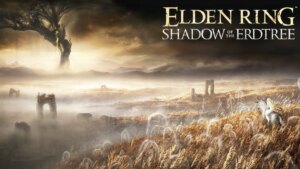
Shadow of the Erdtrees: Studying Arboreal Representations

Given that a gameplay trailer for the anticipated Elden Ring (FromSoft, 2022) DLC, The Shadow of the Erdtree has recently been released, it seems apt to share an update on research I have been conducting on the subject of its eponymous tree. Games such as Elden Ring, The Dark Souls (2011-2017) series and Bloodbourne (2015) (All developed by Fromsoft) constitute a type of high fantasy game known for its evocative worlds and pronounced difficulty (I would argue that the games offer a ‘distinctive difficulty’ as opposed to being straightforwardly difficult). Those who I have spoken to about games in the esteemed ‘Soulsbourne’ categorisation know that I am effusive in my praise for the series. As a result, I had questioned my position as a dispassionate critical observer, and had somewhat reluctantly refrained from writing about Dark Souls (2011), Bloodbourne (2015) and co. That is, until my research projects changed the way I think about settings and spaces in games (as they so often do). Furthering my understanding of post-apocalyptic narratives through ecocritical lenses acquainted me with Alenda Chang’s wonderful book, Playing Nature: Ecology in Video Games (2018). Chang discusses the challenges of graphically depicting the curvaceous, twisting forms of branches and boughs in a generated 3D world primarily constructed of lines and polygons, noting that ‘a single Rhododendron would consist of 30,000 triangles’ (2018). This is in reference to IDV’s SpeedTree service, to which game developers or animators of other practices would outsource the digital rendering of trees, and it led me to questioning what other insights could be gleaned from a close analysis of the representation of arboreal imagery.
In response to this line of questioning, I will be examining Elden Ring in terms of the arboreal imagery it represents and the mythologies it interweaves therein. Connections to the great Ash of Norse mythology, Yggdrasil and the cedar trees of the Gilgamesh Epos are apparent, as are resemblances to Promethean legend, given some of the invective tasks Melina, the Kindling Maiden requests of us as players. It is clear that these narrative echoes are apparent in the game, and I will be making the case for their wider cultural importance based on the treatment of arboreal visualities from other components of Elden Ring. For example, lore exposited as part of item descriptions will also feature as part of the analysis, seeking to qualify the importance of decaying lesser Erdtrees and the ethereal spirit trees of the Mountaintops of the Giants. The relationship between in-game cultural hegemony and mythological hegemonic structures will be examined. Further, the treatment of the Erdtree by the player, the Golden Order (a monotheistic fundamentalist religion dedicated to the worship of Queen Marika) will be explored as an allegory for the hegemonic governance of a land and its ecologies.
Players of the ‘Elden Soulsbourne’ corpus of games will similarly understand the importance of arboreal imagery to other such locations such as The Great Hollow in Dark Souls, the ligneous Things Betwixt, the often-overlooked tutorial area of Dark Souls 2 (2014) and the Curse-rotted Greatwood of Dark Souls 3 (2017). I intend to further explore the meaning and importance of arboreal imagery with specific reference to Elden Ring, but the formerly mentioned games in mind, at this year’s British DiGRA on April 12th.
Works Cited
Chang, A. 2018. Playing Nature: Ecology in Video Games. University of Minnesota Press.
FromSoft 2022 Elden Ring. Single player / multiplayer game, FromSoft.
FromSoft Elden Ring: Shadow of the Edtree 2024. DLC, FromSoft.
FromSoft Dark Souls 2011. Single player / multiplayer game, FromSoft.
FromSoft Dark Souls 2 2014. Single player / multiplayer game, FromSoft.
FromSoft Bloodbourne 2015. Single player / multiplayer game, FromSoft.
FromSoft Dark Souls 3 2017. Single player / multiplayer game, FromSoft.
